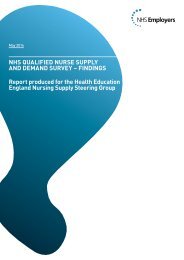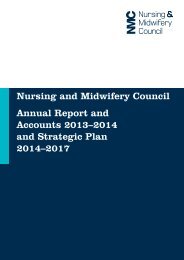Journal_1_2014_final_WEB
Journal_1_2014_final_WEB
Journal_1_2014_final_WEB
Create successful ePaper yourself
Turn your PDF publications into a flip-book with our unique Google optimized e-Paper software.
Authors’ conclusions: There is currently no conclusive evidence<br />
available from randomised trials regarding the benefits or harms<br />
of early versus delayed post-operative showering or bathing for<br />
the prevention of wound complications, as the confidence intervals<br />
around the point estimate are wide, and, therefore, a clinically<br />
significant increase or decrease in SSI by early post-operative<br />
bathing cannot be ruled out. We recommend running further<br />
randomised controlled trials to compare early versus<br />
delayed post-operative showering or bathing.<br />
Plain language summary:<br />
Post-operative bathing and showering to prevent wound<br />
complications<br />
Many people undergo surgical operations during their life-time.<br />
After an operation the surgical wound is closed using stitches,<br />
staples, tape (steri-strips) or an adhesive glue. Usually, towards<br />
the end of the surgical procedure and before the person leaves<br />
the operating theatre, the surgeon covers the closed surgical<br />
wound using gauze and adhesive tape, or an adhesive tape containing<br />
a pad that covers the surgical wound. This is called a<br />
wound dressing. There is currently no guidance about when<br />
wounds can be made wet by bathing or showering post-operatively.<br />
Early bathing may encourage the person to move about,<br />
which is good after most types of surgery. Avoiding post-operative<br />
bathing or showering for two to three days may result in the<br />
accumulation of sweat and dirt on the body, but early washing<br />
of the wound may have a bad effect on healing by irritating the<br />
wound and disturbing the healing environment. We reviewed all<br />
the available evidence from the medical literature (up to July<br />
2013) on this issue. In particular, we sought information from<br />
randomised controlled trials, which, if conducted well, provide<br />
the most accurate information.<br />
We identified only one randomised controlled trial. This trial<br />
was at high risk of bias, i.e. there were flaws in the way it was<br />
conducted that could have given incorrect results. This trial<br />
included 857 people undergoing minor skin operations performed<br />
at a General Practitioner (GP) surgery. No steri-strips<br />
were used in this trial, as the wounds were stitched. The people<br />
running the trial used a method similar to the toss of a coin to<br />
decide which group participants went into. One group of 415<br />
people was advised to remove the dressing 12 hours after surgery<br />
and then to bathe normally, while the other group of 442<br />
people was advised to keep the dressing on for at least 48 hours<br />
and then to bathe normally. The only outcome of interest<br />
reported in this trial was wound infection. The authors reported<br />
no statistically significant difference in the proportion of people<br />
who developed wound infection in the two groups (8.5% in the<br />
early bathing group and 8.8% in the delayed bathing group).<br />
There is currently no conclusive evidence available from randomised<br />
trials about the benefits, or harms, with regard to<br />
wound complications of early or delayed post-operative showering<br />
or bathing. We recommend further randomised controlled<br />
trials to compare early versus delayed post-operative showering<br />
or bathing.<br />
Publication in The Cochrane Library Issue 12, 2013<br />
Antibiotics and antiseptics for venous leg ulcers<br />
Susan O’Meara, Deyaa Al-Kurdi, Yemisi Ologun,<br />
Liza G Ovington, Marrissa Martyn-St James,<br />
Rachel Richardson<br />
O’Meara S, Al-Kurdi D, Ologun Y, Ovington LG, Martyn-St<br />
James M, Richardson R. Antibiotics and antiseptics for venous<br />
leg ulcers. Cochrane Database of Systematic Reviews <strong>2014</strong>,<br />
Issue 1. Art. No.: CD003557. DOI: 10.1002/14651858.<br />
CD003557.pub5.<br />
Copyright © 2013 The Cochrane Collaboration. Published by<br />
John Wiley & Sons, Ltd.<br />
ABSTRACT<br />
Background: Venous leg ulcers are a type of chronic wound<br />
affecting up to 1% of adults in developed countries at some<br />
point during their lives. Many of these wounds are colonised by<br />
bacteria or show signs of clinical infection. The presence of<br />
infection may delay ulcer healing. Two main strategies are used<br />
to prevent and treat clinical infection in venous leg ulcers: systemic<br />
antibiotics and topical antibiotics or antiseptics.<br />
Objectives: The objective of this review was to determine the<br />
effects of systemic antibiotics and topical antibiotics and antiseptics<br />
on the healing of venous ulcers; review authors also examined<br />
the effects of these interventions on clinical infection, bacterial<br />
flora, bacterial resistance, ulcer recurrence, adverse<br />
effects, patient satisfaction, health-related quality of life and<br />
costs.<br />
Search methods: In May 2013, for this second update, we<br />
searched the Cochrane Wounds Group Specialised Register<br />
(searched 24 May 2013); the Cochrane Central Register of Controlled<br />
Trials (CENTRAL 2013, Issue 4); Ovid MEDLINE (1948<br />
to Week 3 May 2013); Ovid MEDLINE (In-Process & Other Nonindexed<br />
Citations, 22 May 2013); Ovid EMBASE (1980 to Week<br />
20 2013); and EBSCO CINAHL (1982 to 17 May 2013). No<br />
language or publication date restrictions were applied.<br />
Selection criteria: Randomised controlled trials (RCTs) recruiting<br />
people with venous leg ulceration, evaluating at least one systemic<br />
antibiotic, topical antibiotic or topical antiseptic that<br />
reported an objective assessment of wound healing (e.g. time to<br />
complete healing, frequency of complete healing, change in<br />
ulcer surface area) were eligible for inclusion. Selection decisions<br />
were made by two review authors while working independently.<br />
Data collection and analysis: Information on the characteristics<br />
of participants, interventions and outcomes was recorded on a<br />
standardised data extraction form. In addition, aspects of trial<br />
methods were extracted, including randomisation, allocation<br />
concealment, blinding of participants and outcome assessors,<br />
incomplete outcome data and study group comparability at<br />
baseline. Data extraction and validity assessment were conducted<br />
by one review author and were checked by a second.<br />
Data were pooled when appropriate.<br />
Main results: Forty-five RCTs reporting 53 comparisons and<br />
recruiting a total of 4486 participants were included, Many RCTs<br />
were small, and most were at high or unclear risk of bias. Ulcer<br />
76<br />
EWMA <strong>Journal</strong> <strong>2014</strong> vol 14 no 1




